Russ Miller: A Liking for Interesting Dialogue.
Posted: Tuesday, February 21, 2006
By: Darren Schroeder
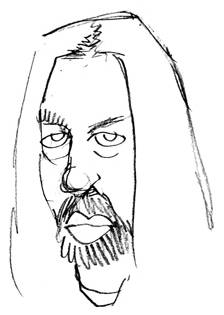
Russ Miller writes and draws a comic called Northangle Nocturne, a charmingly eccentric tale set in a charmingly eccentric town populated by memorable people. The comic is full of interesting ideas and wry observations on the human condition. Thus I couldn’t resist tracking Russ down for a chat about printers, big art, and reading comics in public.
Darren Schroeder: What's your full name?
Russell G. Miller. What goes with the "G" is between me and the Internal Revenue Service.
DS: Age?
RGM: Forty-five. Shocking, isn't it?
DS: How long have you been working in the comics medium?
RGM: Since elementary school -- age eight or nine. I used to draw ridiculous little continuities featuring modified stick-figure guys to bore my friends.
DS: Were comics a big part of your childhood?
RGM: I'm just old enough to have caught the tail end of real Sunday funnies in American newspapers. Not full-page features (I missed those), but true half-page ones, on big sheets and nicely colored. The image of a little kid sprawled on the floor reading a huge comics section on Sunday mornings is an American cliche, but I really used to do that, and it was wonderful.
Then a few years later I managed to get my hands on an omnibus volume reprinting early Crumb, Green, Spiegelman, Spain, Wilson, Griffith, etc., and my doom was sealed.
So I guess the answer to your question is yes indeed, and they still are, since my childhood shows no sign of departing anytime soon.
DS: When did you publish your first comic?
RGM: I had the good fortune to attend the University of Massachusetts at Amherst in the early 1980s, which had a daily (five-times-a-week) newspaper with a homegrown comics page. I drew two different strips for that between 1983 and 1985. In the 1990s I was the graphic designer for a small weekly in Western Massachusetts, where I managed to sneak in a few cartoon drawings here and there (much to the chagrin of the advertising department). But it wasn't until 2005 that I came out with a title of my own.
DS: Is your home town anything like Northangle?
RGM: Where I live now isn't, but Northangle does have certain things in common with Springfield, Massachusetts, in and around which I grew up. They are both economically depressed former mill towns with some interesting people living in them.
DS: Are you the same Russ Miller that drew for Gladstone Publishing's Walt Disney comic books in the early 1990s?
RGM: I think I would remember that. No, wait. Maybe I wouldn't.
Just another of the millions of unrelated Millers kicking around America. Damned nuisance. Ego-surfing is all but impossible for me.
DS: How do you schedule time to get stuff drawn?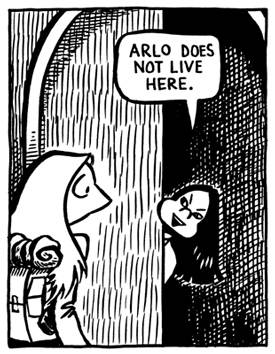 RGM: A half-hour here, an hour there, evenings and weekends. It takes a lot longer this way, but I'm very happy to have the extra time to write the scripts, most of which I write a line or two at a time while taking walks or showers. I'm not sure I would know how to do it just sitting at a table for hours at a time.
RGM: A half-hour here, an hour there, evenings and weekends. It takes a lot longer this way, but I'm very happy to have the extra time to write the scripts, most of which I write a line or two at a time while taking walks or showers. I'm not sure I would know how to do it just sitting at a table for hours at a time.
DS: Are your fingers covered in ink stains?
RGM: I'm quite fastidious about my hands.
DS: What does the term Small Press mean to you?
RGM: I don't follow the industry terribly closely, but I can tell you what it means for me and my own work: it means I can tell exactly the story I want to tell without having to explain it to anyone first. This is the beauty of self-publishing, for me. It's not the road to financial success, however!
DS: So Northangle Nocturne is your first standalone comic? Wow! How long have you been working on it?
RGM: It’s the first standalone comic I’ve published, anyway. In 1993 I put together a sample issue of a comic I was planning to call “Misanthrope,” but it didn’t generate much interest and I wasn’t really happy with it. So it stayed in the can. (I may yet publish parts of it.)
Northangle Nocturne 1 took me about a year and a half to complete. But that includes inking about a quarter of it, throwing that away, starting over and inking half of it, throwing that away, then starting over again and finally finishing it.
DS: Do you have an overall script for the series, or is still a work in progress?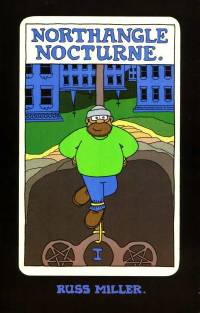 RGM: Northangle Nocturne 2 is fully scripted. I have a stack of handwritten notes for Northangle Nocturne 3. I have thoughts about things that will happen in subsequent issues, and a vague idea about the shape of the series. It's definitely a work in progress. ("The road to hell is paved with works-in-progress." -- Philip Roth)
RGM: Northangle Nocturne 2 is fully scripted. I have a stack of handwritten notes for Northangle Nocturne 3. I have thoughts about things that will happen in subsequent issues, and a vague idea about the shape of the series. It's definitely a work in progress. ("The road to hell is paved with works-in-progress." -- Philip Roth)
DS: What do you do to pay the bills?
RGM: I’m a Librarian at a small liberal-arts college. For some rather ill-defined reason when I was about twenty-five I decided I wanted a real career, as opposed to spending a few decades working in a photocopy shop. So I got my Master’s degree, and here I am, gainfully employed, free to pursue whatever cockamamie schemes I can squeeze into my off hours.
DS: Much in the way of comic material in the Library?
RGM: I could write a book. But that comes later.
DS: Give us the readers digest version: Too many comics? Too Little?
RGM: Sorry, I misunderstood the question. We only have a dozen, maybe a dozen and a half titles, and many of those are here because I recommended them. Comics and/or graphic novels are not really the sort of thing our students expect to find in our library -- there isn't much time for non-scholarly reading while school is in session.
On the other hand, some graphic novels are taught in classes -- or at least mentioned (Maus & Persepolis, to name two). Sooner or later we will have a course in graphic novels, I'm quite sure. Then I expect we'll be buying a bunch more.
I will have to give in and buy some manga for the library soon, I expect. (I'm afraid I put most manga in roughly the same category as American superhero stuff: undifferentiated pap.)
DS: Do they have good photocopiers?
RGM: Yes indeed, but with the advent of the scanner and PhotoShop, who needs them? (Well, I would if I wanted to do mini-comics. But I like to have stuff printed.)
DS: What sort of comics appeal to you?
RGM: I like work that is idiosyncratic and personal. But not necessarily autobiographical. In fact, I’m not crazy about a lot of the confessional stuff that’s so common now. There seems to be this idea that if something really happened to you, it must be worth telling. Folks, that’s what imagination is for.
One exception: Julie Doucet can write about any actual dream she ever had.
What I mean by personal is work that couldn’t have been done by anyone else on the planet. The obvious example is George Herriman’s Krazy Kat, but I also love Elsie Segar’s Popeye and Schulz’ Peanuts. Julie Doucet is a genius. Bill Griffith is my hero. Chester Brown’s work brings tears to my eyes.
I have to admit I haven’t read much new stuff in the last ten years. Chris Ware’s Jimmy Corrigan book is beautiful, just about perfectly executed. It’s also the single most depressing book I’ve ever read.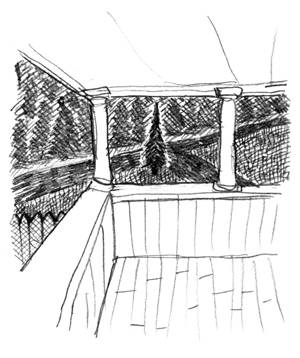 DS:DS:Well said regarding imagination, but I can't help reflecting that a lot of the fiction out there doesn't exactly overflow with originality, and autobiographical material at its worst at-least says something about a real person out there in the world. What sort of autobiographical stories would you like a moratorium placed on?
DS:DS:Well said regarding imagination, but I can't help reflecting that a lot of the fiction out there doesn't exactly overflow with originality, and autobiographical material at its worst at-least says something about a real person out there in the world. What sort of autobiographical stories would you like a moratorium placed on?
RGM: I'll have to defer to you about the quality of imaginative fiction in comics these days, since I haven't really kept up. But I differ from a lot of people in that I don't think a story's being true makes it a better story. Partly this is just a matter of my own tastes and prejudices. I completely agree with the American novelist John Barth, for example, who once said "Realism is a fucking bore." An atmospheric little slice-of-life comic about how pleasant, or melancholic, or strange it is to walk by your ex-girlfriend's apartment building on a rainy Sunday night doesn't give me a warm feeling of True Experience Recognized. It might make me think, "I've done that." Well, so I have. So what? I'm quite capable of providing my own ongoing narrative of my own life in my head as I walk around looking at ex-girlfriends' apartment buildings.
I'm also not interested in 'realistic' dialogue. If you've ever seen a transcript of an actual conversation, you know it makes for maddening reading, with all the ums, ahs, repetitions, and mistakes. I like interesting dialogue. I don't care in the slightest if it's made up of sentences no human being ever uttered in a real conversation.
In short, I don't subscribe to the idea of art as holding up a mirror to life. Harvey Pekar says he wants to push people into their lives. Thanks Harv, but I'm plenty far enough into mine at the moment.
Actually, I like a lot of Harvey Pekar's work. Disregard everything I just said.
DS: Some people find Chris Ware’s work overdone graphically - are they nuts or the voice of sanity?
RGM: I like a certain amount of density and complication in a comic book. Jimmy Corrigan really worked for me in that respect.
However, I did happen to pick up another of his titles in a bookstore the other day -- I think it was Quimby the Mouse -- and my thought was: is this cartooning or is this undiagnosed obsessive compulsive disorder?
I do a very detailed pencil drawing, then do the inking on a fresh sheet of paper laid on top. (I use a light table for this.) Then I scan the inked sheets into PhotoShop for touching up.
DS: What art materials do you use creating your comic?
RGM: I’m still experimenting with papers and inks. NN 1 was inked with a Rapidograph pen on very cheap paper. I was trying to get myself to loosen up. Unfortunately the very cheap paper wicked ink like crazy and led to many long hours of PhotoShop touchups. So much for looseness. NN 2 will probably be inked with an old-fashioned Speedball nib. Or maybe a brush.
I do a very detailed pencil drawing, then do the inking on a fresh sheet of paper laid on top. (I use a light table for this.) Then I scan the inked sheets into PhotoShop for touching up.
DS: Describe your drawing work area?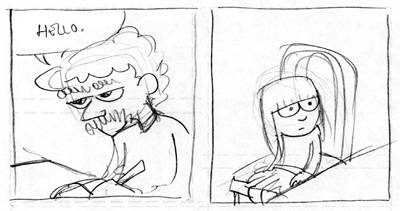 RGM: The innards from a good-sized second-hand light table are propped up on an improbable arrangement of boards, cardboard, and C-clamps, all more or less attached to the top of an ordinary kitchen table (which is not, however, in a kitchen). A few feet away sits an aging Mac G-3 and a scanner.
RGM: The innards from a good-sized second-hand light table are propped up on an improbable arrangement of boards, cardboard, and C-clamps, all more or less attached to the top of an ordinary kitchen table (which is not, however, in a kitchen). A few feet away sits an aging Mac G-3 and a scanner.
DS: Any photoshop tips you care to share?
RGM: Do the best drawing on paper you can. It will save you a lot of time!
Seriously, I work very laboriously in PhotoShop. It's a great tool, but I'm no wizard.
DS: What was the biggest hassle in the printing of the book?
RGM: I did production graphic design for a while, so the process went fairly smoothly. I made a few mistakes in the file formats and messed up the colors on the covers a little, but the printers kindly helped me sort things out. I used local people, because I wanted to be able to talk to them face to face. They were super.
DS: They did a great job, who are these kings amongst printers?
RGM: The Inkspot Press in Bennington, Vermont, U.S.A. I salute them.
DS: Is there much of a comic creating community in Springfield?
RGM: It’s been a while since I lived there, so I really don’t know. Also, I’ve always gone my own way. I’ve never hung out with cartoonists. It’s always seemed like a pretty solitary sport to me.
DS: What sort of music belongs on the Northangle Nocturne soundtrack?
RGM: Maybe Little Umbrellas by Frank Zappa, some Velvet Underground, and some little piano pieces by Erik Satie.
DS: What the most memorable comic you've read, and why was it memorable?
RGM: Every issue of Dirty Plotte by Julie Doucet. I have a special fondness for number 3, because it contains “Oh La La What a Strange Dream!” in which Julie dreams she is an astronaut and finds a new use for cookies. Her work is beautiful, funny, sad, disturbing, and intensely individual. And she has that truly rare talent among cartoonists, which is something I prize very highly: she draws funny.
DS: where's the must unusual place you've read a comic?
RGM: I'm a pretty boring guy, actually. I can't remember ever reading a comic in an unusual place.
DS: Do you read comics in public much?
RGM: Not often, I have to admit. And then, I'm most likely to be reading something already collected in book form. (I mean, then at least it LOOKS like a book, right?)
Part of my problem is that I really don't much care for the typical individual issue of a comic -- I don't like the size, the flimsiness, the paper (unless it's on good paper, which some are now). That's why I made my book little, book-sized. And actually, I would have preferred to publish a 200-page book instead of a 41-page one, but I wanted to put something out before I turn fifty.
DS: Do you use much reference material when producing your comics?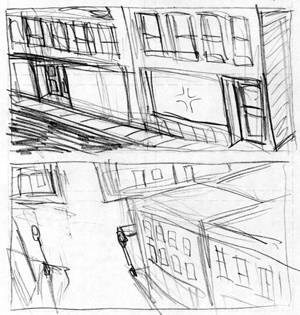 RGM: When I was first thinking about Northangle Nocturne, I spent a little time walking around a certain small city in Western Massachusetts (not Springfield) taking photographs of empty storefronts and architectural details. I refer to them occasionally, just as a starting point. I can’t be bothered to draw stuff realistically, but sometimes I just can’t figure out what something should look like, and then it helps to look at a photograph.
RGM: When I was first thinking about Northangle Nocturne, I spent a little time walking around a certain small city in Western Massachusetts (not Springfield) taking photographs of empty storefronts and architectural details. I refer to them occasionally, just as a starting point. I can’t be bothered to draw stuff realistically, but sometimes I just can’t figure out what something should look like, and then it helps to look at a photograph.
I tell a lie. On page 9 of NN 1 is a drawing of Tucumcari Mountain in New Mexico, based on a couple of photographs I found on the Internet. It isn’t especially accurate, but it’s the most reality-based drawing in the book.
I also referred to a deck of Rider-Waite tarot cards for this issue, and a book of color reproductions of works by the early modernist painter Giorgio de Chirico.
And I have a book of photographs of American automobiles that came in handy a few times. I have trouble drawing cars.
DS: Whose story is being told in NN, is it Sol's or the town's?
RGM: I think both...and also Jake's, Jack's, the Mayor's, and those of some people who haven't showed up yet.
DS: Jack the mayor is a metaphor for government surveillance of the American public; discuss
RGM: That's not what I had in mind, but other people's interpretations are always interesting to me.
DS: Is there really a Museum of really big art?
RGM: Yes, there is. It's called Mass MoCA: The Massachusetts Museum of Contemporary Art, and a major part of its mission is to exhibit large works that are not easily displayed elsewhere. (See, I don't make up everything!)
DS: People keep stealing public sculptures in New Zealand to sell as scrap metal, but so far they have all been caught. What work of art would you like to steal and why?
RGM: Are they thieves or art critics?
Stealing art isn't my thing. Stealing ideas -- that's a different matter entirely.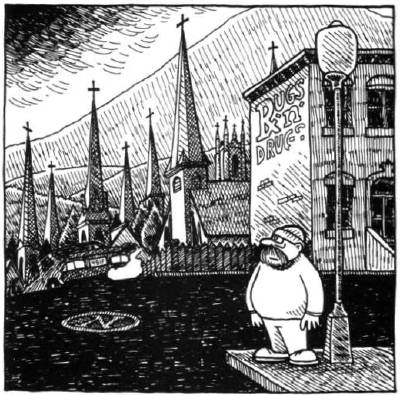 DS: Do you collect people's stories, or make them all up?
DS: Do you collect people's stories, or make them all up?
RGM: I don't collect stories. I listen and observe a lot, though. There may be some future stories in NN that are based on true stories, but I never tell a story straight -- my memory isn't that good! I always make stuff up.
DS: Are all the quotes in the front of the comic real?
RGM: Yes, indeed. Quotations are my favorite form of literature. I read a lot, and I'm always scribbling things down that strike me.
Of course, I do make them up sometimes, too.
DS: Which comic artist has had the most influence on your style?
RGM: I recently looked at a few of my old daily strips from college, and I was dismayed to find that I had unconsciously stolen the punchlines (not to mention the verbal style) of a few Peanuts strips from the 1960s. I've still got all these great lines from all the comics I've ever read (and books, films, etc.) rolling around in my head, and they still try to sneak into my work sometimes, but I'm much more vigilant about this than I used to be. (Of course sometimes I quote something deliberately.)
Visually, I can't tell. Someone else will have to figure that out.
DS: Why should someone buy your comic?
RGM: Despite having taken a course in mass communication when I was in college, I don't have the slightest idea why anyone buys anything. And I have a natural antipathy to salesmanship. Either people will buy it or they won't.
DS: Has your skill in drawing comics ever got you a date?
RGM: Playing the guitar always worked much better. Being a cartoonist has often been a distinct negative. Most of the women I've met have never read any comics, and have never seen anything but superhero comics. (Except: they've all heard of Maus. They haven't read it, but they've heard of it.)
I understand this is changing -- a little -- among younger folks.
DS: My thanks to Russ for the time he spent chatting with me via e-mail. He can be contacted via:
russ@roothogrecords.com
http://www.roothogrecords.com
PO Box 313, Petersburgh, NY , 12138, USA.
You really should buy a copy of his comic: Northangle Nocturne #1.
If you have a comment or question about Small Press then feel free to contact me